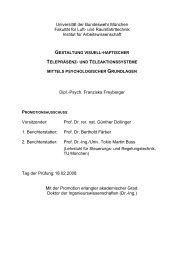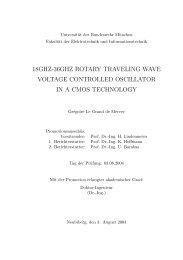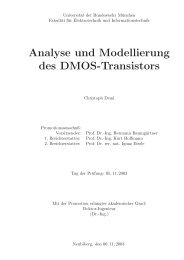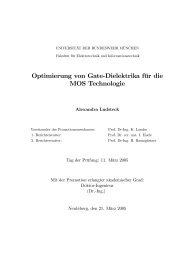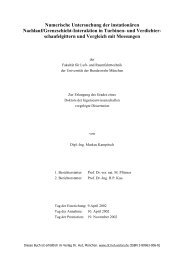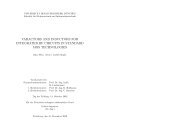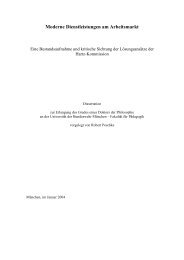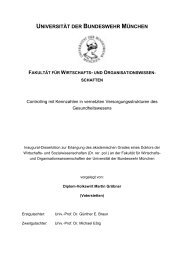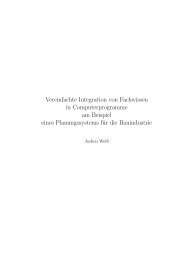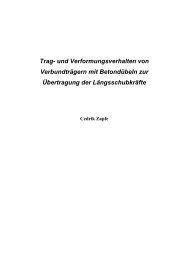Precise Orbit Determination of Global Navigation Satellite System of ...
Precise Orbit Determination of Global Navigation Satellite System of ...
Precise Orbit Determination of Global Navigation Satellite System of ...
Create successful ePaper yourself
Turn your PDF publications into a flip-book with our unique Google optimized e-Paper software.
Chapter 6 Algorithms <strong>of</strong> <strong>Orbit</strong> <strong>Determination</strong> <strong>of</strong> IGSO, GEO and MEO <strong>Satellite</strong>s<br />
Runge-Kutta algorithm does, but it can not integrate the differential equation directly from initial condition y0, it<br />
needs y0, y1, y2, ..., yq that can be provided by Runge-Kutta algorithm.<br />
6.1.3 Cowell Algorithm<br />
Cowell integration algorithm can solve following form <strong>of</strong> differential equations:<br />
&y<br />
( t)<br />
= f ( t,<br />
y)<br />
�<br />
�<br />
y&<br />
( t0)<br />
= y&<br />
0 �<br />
y(<br />
t =<br />
�<br />
0)<br />
y0<br />
�<br />
There are also two kinds <strong>of</strong> algorithms, prediction and calibration. The Cowell prediction algorithm is:<br />
(Cappellari et al 1976 and Xu 1989)<br />
q �<br />
2<br />
y = 2y<br />
− y + h β f �<br />
β<br />
σ<br />
c<br />
n+<br />
1<br />
k<br />
m<br />
j<br />
0<br />
=<br />
= 1−<br />
=<br />
�<br />
m=<br />
k<br />
j<br />
q<br />
�<br />
i=<br />
1<br />
σ = 1<br />
n<br />
k �m<br />
�<br />
( −1)<br />
�<br />
�<br />
�<br />
�σ<br />
m<br />
� k �<br />
m−1<br />
�<br />
j=<br />
0<br />
1<br />
i<br />
n−1<br />
2<br />
c jσ<br />
j + 2<br />
�<br />
k = 0<br />
m−<br />
j<br />
k<br />
n−k<br />
�<br />
�<br />
�<br />
�<br />
�<br />
�<br />
�<br />
�<br />
�<br />
�<br />
�<br />
�<br />
�<br />
�<br />
�<br />
��<br />
and Cowell calibration algorithm can be written as (Cappellari et al 1976 and Xu 1989)<br />
q �<br />
2 *<br />
yn+<br />
1 = 2y<br />
n − yn−1<br />
+ h � β k f n−k<br />
+ 1 �<br />
k=<br />
0 �<br />
q<br />
�<br />
* �m<br />
� *<br />
�<br />
β k = � �<br />
�<br />
�<br />
�σ<br />
m<br />
�<br />
= � k<br />
m k �<br />
�<br />
m−1<br />
�<br />
* 2 *<br />
�<br />
σ m = −�<br />
c jσ<br />
m−<br />
j �<br />
j + 2<br />
j=<br />
0<br />
�<br />
j<br />
�<br />
1<br />
�<br />
c j = � i<br />
�<br />
i=<br />
1<br />
�<br />
σ = 1<br />
�<br />
0<br />
�<br />
��<br />
67<br />
(6-8)<br />
(6-9)<br />
(6-10)<br />
In practice, the prediction and calibration are combined to integrate the differential equation, first using<br />
prediction to compute the approximate yn+1 and also compute the right function with a certain accuracy and then<br />
using calibration to solve more precise yn+1.<br />
6.1.4 Numerical Integration <strong>of</strong> <strong>Satellite</strong> Dynamic Movement Equation<br />
The satellite movement equation Eq.(6-2) can be equally written as follows



